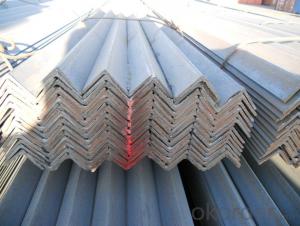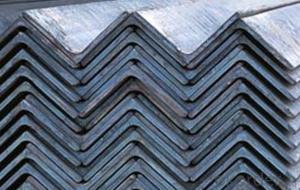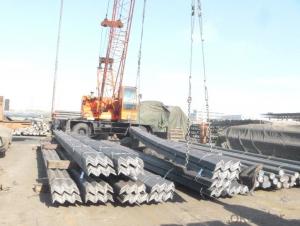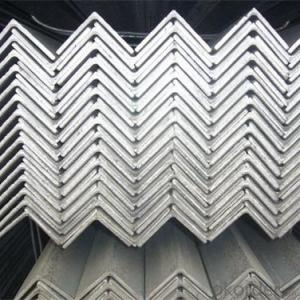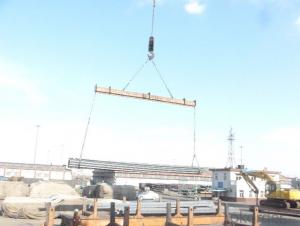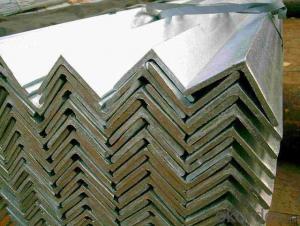Hot rolled equilateral angle steel
- Loading Port:
- China Main Port
- Payment Terms:
- TT OR LC
- Min Order Qty:
- -
- Supply Capability:
- -
OKorder Service Pledge
OKorder Financial Service
You Might Also Like
Angle called angle, strip steel is perpendicular to each other on both sides into angular.There are equilateral angle steel and unequal angle of. Equilateral angle steel two edge widthequal. The specification is expressed by edge width x edge width * thick edge millimeternumber. Such as "front 30 x 30 x 3", namely said equilateral angle steel edge width of 30 mm,3 mm thick edge. Also available models represent models is the edge width, number of centimeters, such as angle 3#. Models of the same model that in the different edge thickness and size, and thus in the contract documents general boundary angle width, edge thick size fill in complete, avoid use alone model said. Hot rolled equilateral angle steel specifications for 2#-20#. Angle according to the different needs of structure composed of a variety of stress components, but also can be used as a component of the connections between the.Widely used in a variety of architectural and engineering structures, such as beams, bridge,tower, lifting the transport machinery, ships, industrial furnace, reaction tower, container frame and warehouse.
Angle profile
Angle according to the different needs of structure composed of a variety of stress components, but also can be used as a component of the connections between the. Widely used
In a variety of architectural and engineering structures, such as beams, bridge, tower, lifting the transport machinery, ships, industrial furnace, reaction tower, container rack, cable channel support, power piping, bus mounting bracket, and warehouse shelves.
Angle is built with carbon structural steel, is a simple section steel steel, mainly used for metalcomponents and the frame of the plant. In use requires a good weldability, plastic deformation and certain mechanical strength. The production of raw materials for low carbon steel billetsteel billets, finished angle for the hot rolling, normalizing or hot-rolled state of delivery.
Type specification
Mainly divided into equilateral angle steel and equilateral angle steel two categories, includingunequal angle can be divided into equilateral equilateral thick and unequal thickness two.
Angle specifications expressed with side length and edge thickness size. At present domesticsteel specifications for 2 - 20 cm in length, number number, the same horn steel often have 2- 7 different edge thickness. The actual size and edge inlet angle marked on both sides of thethickness and indicate the relevant standards. The general length of more than 12.5cm for large angle, 12.5cm - 5cm for the medium angle, length below 5cm for small angle.
Inlet and outlet angle steel orders generally required the use specifications in the main, thesteel is carbon steel grades corresponding. Is the angle in addition to standard number, nospecific composition and performance series. Angle iron delivery length is divided into fixed length, double length two, domestic angle of fixed length of choice scope has 3 9m, 4 12M, 419m, 6 19m four scope according to the specifications of different. Japanese angle length selection range is 6 - 15m.
Section unequal angle height according to the long edge of the width to calculate the scalene angle steel. Refer to section for angular and both sides unequal in length of steel. Is an angleof. Its length from 25mm * 16mm to 200mm * l25mm. From the hot rolling mill and rolling.General specifications for: scalene angle steel angle 50*32-- angle 200*125 thickness of 4-18mm
Unequal angle steel is widely used in all kinds of metal structures, bridges, machinery manufacturing and shipbuilding, building structure and engineering structures, such as beams, bridges, power transmission tower, lifting the transport machinery, ships, industrial furnace, reaction tower, container frame and warehouse etc..
Import and export
China's import and export have a certain angle each batch, mainly imported from Japan andWestern europe. Exports to Hong Kong and Macao, Southeast Asia, the area is mainly on Latin America and Arabia countries etc.. Export production enterprises mainly in Liaoning,Hebei, Beijing, Shanghai, Tianjin and other provinces and cities of iron and steel plant (rolling mill).
Angle for the large variety of imports, small angle and special shape angle, export varieties for the medium angle such as 6, 7, etc..
- Q: Can steel angles be used in the construction of sports stadiums?
- Yes, steel angles can be used in the construction of sports stadiums. Steel angles are versatile structural elements that can be used to support heavy loads and provide stability in large structures like sports stadiums. They are commonly used in the construction industry for various applications, including framing, support columns, and bracing systems. Steel angles offer excellent strength and durability, making them suitable for withstanding the dynamic forces and heavy loads experienced in sports stadiums. Additionally, steel angles can be easily fabricated and customized to fit the specific design and structural requirements of the stadium, offering flexibility in construction. Overall, steel angles are an ideal choice for the construction of sports stadiums due to their strength, versatility, and ability to withstand the unique demands of such large-scale structures.
- Q: What are the different test methods used to evaluate steel angles?
- To ensure the quality and suitability of steel angles for different applications, multiple test methods are employed. These methods encompass: 1. Tensile Test: Assessing tensile strength, yield strength, and elongation, this test applies an increasing load to a specimen until it breaks. It gauges the material's ability to withstand forces without deformation or fracture. 2. Bend Test: Evaluating flexibility and ductility, this test bends a specimen to a specific angle, examining it for signs of cracking, fracture, or deformation. Its purpose is to determine the angles' structural integrity when subjected to bending forces. 3. Charpy Impact Test: Measuring impact resistance and toughness, this test subjects a notched specimen to a high-velocity impact. The energy absorbed during impact reveals the material's ability to withstand sudden loads or shocks. 4. Hardness Test: Determining resistance to indentation or scratching, this test employs various methods like Rockwell, Brinell, or Vickers to evaluate hardness properties. It aids in assessing durability and wear resistance. 5. Ultrasonic Testing: This non-destructive method uses high-frequency sound waves to detect internal flaws or defects within the steel angles. It identifies cracks, voids, or inclusions that may compromise structural integrity. 6. Dimensional Inspection: Measuring dimensions, tolerances, and geometric properties, this test ensures compliance with required specifications. It provides accurate information for engineering calculations and fabrication processes. By utilizing these diverse test methods, manufacturers, engineers, and quality control personnel can thoroughly evaluate the mechanical properties, structural integrity, and overall quality of steel angles, thus ensuring their suitability for specific applications.
- Q: What is the standard length of a steel angle?
- The specific requirements and industry or project standards can lead to variations in the standard length of a steel angle. Typically, steel angles are readily accessible in standard lengths of 20 feet or 6 meters. These standard lengths facilitate transportation, handling, and installation. Nevertheless, it is worth mentioning that custom lengths can also be manufactured to fulfill project-specific requirements.
- Q: Do steel angles come with any warranties?
- Yes, steel angles typically come with warranties provided by the manufacturer or supplier. These warranties may vary in terms of duration and coverage, so it is important to check the specific warranty details offered by the supplier before making a purchase.
- Q: Can steel angles be drilled or cut?
- Yes, steel angles can be drilled or cut using appropriate tools and techniques.
- Q: What are the different methods of surface preparation for painting steel angles?
- There are several methods of surface preparation for painting steel angles, each of which have their own benefits and considerations. 1. Manual cleaning: This method involves using hand tools such as wire brushes, sandpaper, or scrapers to remove loose rust, mill scale, and other contaminants. While it is a cost-effective option, it may not be suitable for large-scale projects or areas that are difficult to access. 2. Power tool cleaning: Power tools like grinders, sanders, or wire wheels can be used to mechanically remove rust, scale, and old paint from the surface of steel angles. This method is more efficient than manual cleaning and can be used in larger projects, but proper safety precautions and protective gear should be used. 3. Chemical cleaning: Chemical cleaning involves using solvents or acidic solutions to dissolve rust and remove contaminants from the steel surface. This method is effective for heavily corroded or hard-to-reach areas, but it requires careful handling and disposal of the chemicals. 4. Abrasive blasting: Abrasive blasting, also known as sandblasting, uses compressed air to propel abrasive materials such as sand, grit, or glass beads onto the surface of steel angles. This method is highly effective in removing all types of contaminants, providing a clean and rough surface for paint adhesion. However, it requires specialized equipment and should be conducted by trained professionals due to potential health hazards. Regardless of the method chosen, it is essential to ensure that the steel angles are thoroughly cleaned and free from contaminants before painting. This will help to achieve better paint adhesion, prolong the lifespan of the coating, and enhance the overall durability of the steel structure.
- Q: How do you calculate the load-bearing capacity of a steel angle?
- To calculate the load-bearing capacity of a steel angle, you need to consider factors such as the dimensions of the angle, the material properties of the steel, and the type of loading it will experience. The load-bearing capacity can be determined using engineering formulas or reference tables that take into account the angle's cross-sectional area, moment of inertia, and the yield strength of the steel. Additionally, structural design codes and standards should be consulted to ensure the calculated load-bearing capacity meets the required safety factors and regulations.
- Q: Can steel angles be used for platform structures?
- Yes, steel angles can be used for platform structures. Steel angles are commonly used in construction for their strength, durability, and versatility. They provide structural support and stability to various types of platforms, including elevated walkways, mezzanines, catwalks, and scaffolding. Steel angles offer excellent load-bearing capacity and can withstand heavy loads, making them suitable for platform structures that require a high level of strength and stability. Additionally, steel angles can be easily fabricated and joined together, allowing for efficient construction and customization of platform structures.
- Q: How do you calculate the moment resistance of a steel angle connection?
- To calculate the moment resistance of a steel angle connection, you need to consider factors such as the geometry of the connection, the material properties of the steel angle, and the applied loads. The moment resistance can be determined by analyzing the section properties of the angle, such as the moment of inertia and the distance from the centroid to the extreme fiber. Additionally, you need to consider the strength of the steel material, typically provided by the manufacturer. By combining these factors and using appropriate design equations or software, you can calculate the moment resistance of the steel angle connection.
- Q: What are the different methods for joining steel angles?
- There are several methods for joining steel angles, each with its own advantages and applications. Some of the most common methods include welding, bolting, and using adhesive or epoxy. Welding is a popular method for joining steel angles as it provides a strong and permanent connection. It involves melting the edges of the angles with a welding torch and then allowing them to cool and solidify, creating a bond between the two pieces. Welding can be done using various techniques such as arc welding, MIG welding, or TIG welding, depending on the specific requirements of the project. Bolting is another method commonly used to join steel angles. It involves using nuts and bolts to secure the angles together. This method allows for easy disassembly and reassembly if needed, making it suitable for situations where flexibility is required. Bolting also does not require any heat or special equipment, making it a relatively simple and cost-effective option. Using adhesive or epoxy is a non-traditional method for joining steel angles. It involves applying a strong adhesive or epoxy to the contact surfaces of the angles and then pressing them together. This method can provide a strong and durable bond, especially when using high-strength adhesives designed for metal bonding. Adhesive bonding is often used in situations where welding or bolting may not be feasible or desired, such as with thin or delicate materials. Overall, the choice of joining method for steel angles depends on factors such as the specific application, desired strength and durability, ease of installation, and the need for disassembly or flexibility. Consulting with an expert or engineer is recommended to determine the most suitable joining method for a particular project.
Send your message to us
Hot rolled equilateral angle steel
- Loading Port:
- China Main Port
- Payment Terms:
- TT OR LC
- Min Order Qty:
- -
- Supply Capability:
- -
OKorder Service Pledge
OKorder Financial Service
Similar products
Hot products
Hot Searches
Related keywords












